Welcome to my wee corner of Substack. I am a seasonal artist living on the Isle of Arran, off the west coast of Scotland. I am the custodian of approximately two acres of land that includes a woodland, a meadow and my wee garden. I offer a seasonal book arts project for paid subscribers if you are interested and you can read more about that HERE. Grab a cuppa and lets delve into our relationship with the shifting seasons…
Summer is the most challenging season for me as I find I wilt in too much sun. Living on a small Scottish island it is rare that it is too hot but, nevertheless, I get prepared. I fill project baskets that I can just lift and take out to the garden under my favourite tree or away in my beloved van, Willow. What binds these projects together is that they can’t be done quickly and they each require lots of time to complete. They all have a meandering quality about them, making them perfect for slow summer days.
Briefly, on the topic of slow living I am rarely convinced by the many suggestions out there. My experience of slow living began with a deep dive into understanding time and my relationship with it. More than ten years ago I shifted that relationship and stopped chasing time as a result of my new understanding. I rarely plan my day finding that planning days leads to time chasing. I learnt how to let my day come to me and find its own rhythm. Of course, this is made possible as I work from home and I am self employed but those were deliberate decisions as well. Working for other folk and away from home made me largely unhappy and I didn’t realise that until I changed my working patterns. There is the significant word for me - pattern. I allow my day to shape itself almost as if it were one of those dots of ink dropped into water. So, sometimes my working day can expand endlessly and other times the ink drop disappears in a relatively short time. I have come to understand that that is influenced by my natural energy levels and my creative flow. Neither of these are constants and when I understood that I let the patterns within each day guide me. That is how I have made slow living work for me.
As an artist creative flow is an essential element of my practice and I invest heavily in it. Part of this investment is having these baskets of creative projects that can not be rushed. In essence, what they provide is creative rest and that is essential in understanding how creative flow works. Creative flow allows you to stay in the string of creative moments and often produce your best work. This is your creative brain working at its optimal level and that is, by definition, demanding. To counterbalance that level of commitment you need to allow the creative brain to rest.
We can all find our own way of achieving that. For me this is slow stitching. There is something about the repetitive movement of the needle that instantly puts my brain into rest mode. For this to be achieved though the project has to be accessible. This means it can’t be a piece for an exhibition for example and so I choose my projects with great care. I thought I would share what is likely to find itself into my garden stitching baskets.
In 2018 I began a stitching journal inspired by the work of
and in my world she is the guru on slow stitching. I use a piece of Japanese linen and when I get to the end I just stitch another piece on. I like to use my journal to create simple patterns or even pictures with simple stitches. Nothing that demands too much of me.Over the years I have come to love my stitching journal and it is a much treasured item in my creative world. A few years ago I stumbled across stitched snippet rolls and I have been hooked ever since. These travel well so I always have one in my van with me and they are the perfect way to use up old scraps. I never have a plan except that I do tend to make them seasonally. Three months or so seems to be a good time to complete them and I hang them in my creative space and they always make me smile.

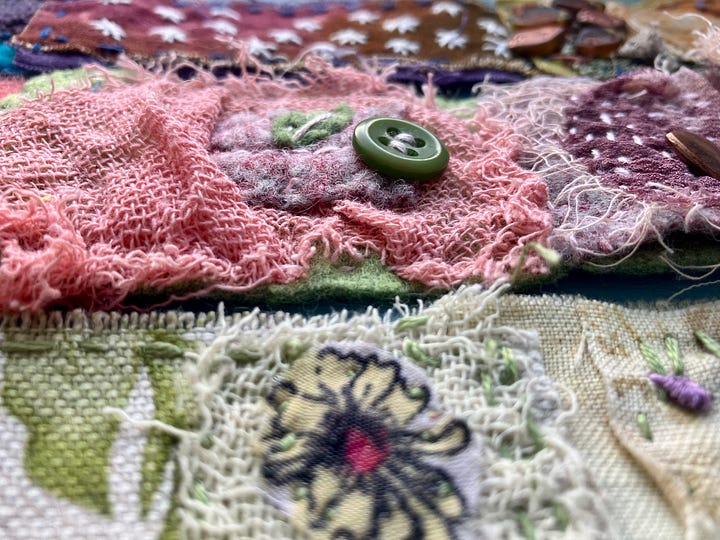
I wind mine round a wooden thread spool and even the winding seems to calm me down.
Kantha stitching comes to us from the Bengal region of the world and has a strong repetitive quality about it. I tend to stick to running stitch and create flowing patterns with it which I also feel calms my nervous system. We could all do with doing that from time to time. Over the years I have completed many Kantha projects but perhaps my favourite project was the sunflower one that I created as a workshop to raise funds for the people of Ukraine. I obviously had to complete a sample before the workshop and I can still remember those precious times of stitching in repetitive circles.
I am a huge fan of meditation and have it in my living tool box. Sometimes getting into a meditative state can be a challenge. I am a meditation teacher so sometimes we begin our new meditation journey by creating some wee stitch meditations. Tiny stitcheries that we can hang in our homes to remind us to meditate.
I use small pieces of recycled wool blanket or felt as a base and just layer and stitch. Joyful.
I could go on and on as I have lots of projects but I will end with one inspired by the work of Emma Freeman when I attended an online workshop where she showed us her tiny stitched books. It is fair to say that I might be a wee bit obsessed with these. I make them throughout the year and I never have any plans. As I dye and print a lot of my fabric it is so lovely to select some small pieces and stitch a wee book together and then stitch on each page. Emma taught me that sometimes less is more and I have really embraced this. One year I put them out during an open studio event and they were so popular. So many people left saying they were going to begin their own book collection.
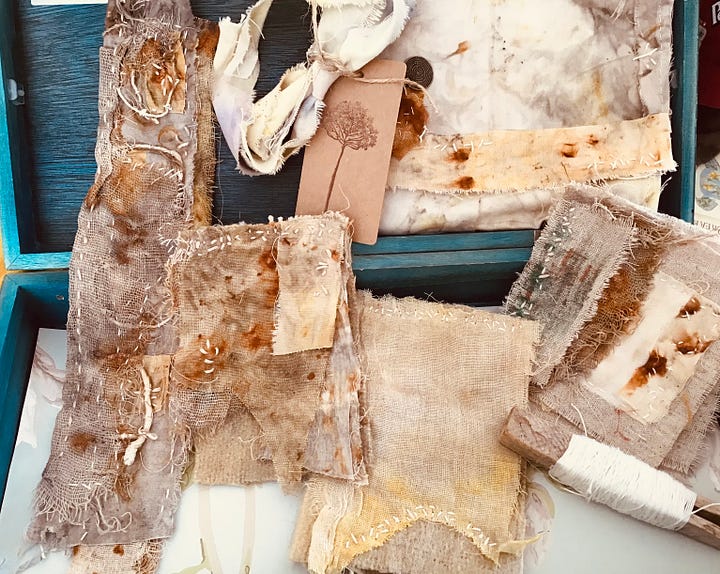
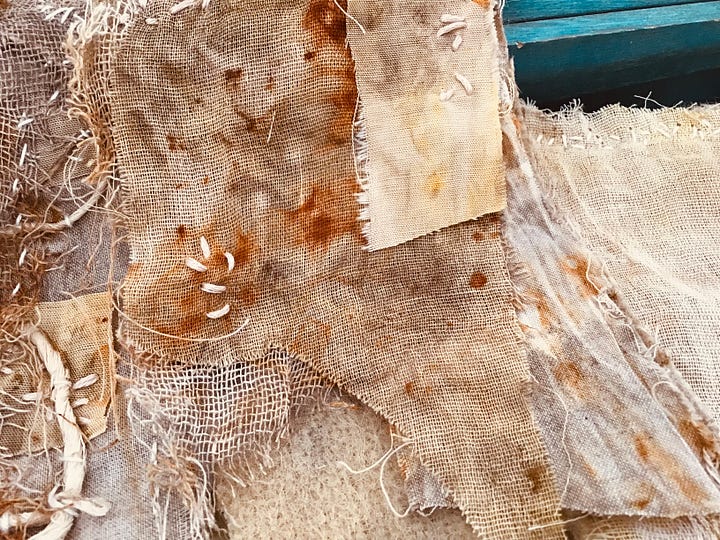
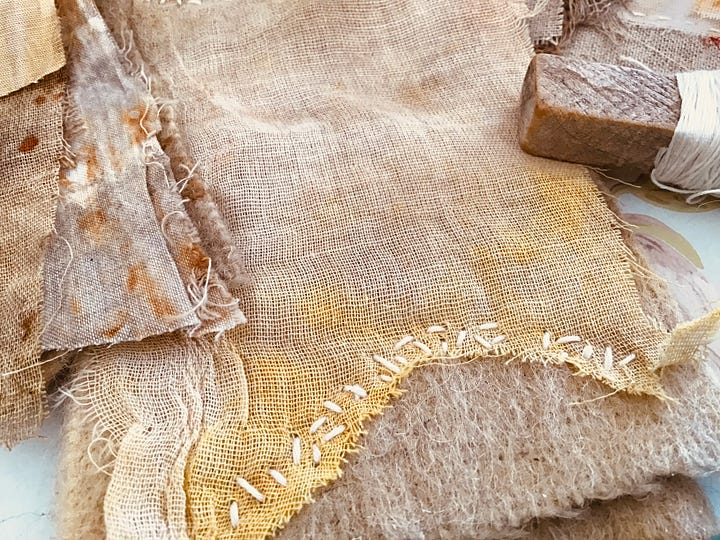
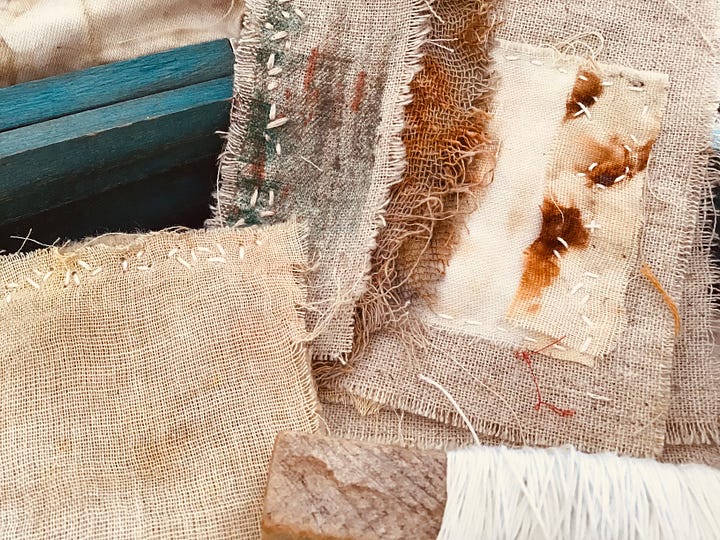
Like Emma, I have a habit of burying fabric pieces with rusty metal and plants and then digging it up to see what marks have been made. These pieces often find themselves into my stitched book library. I always have a wee stitched book on the go and, over the last few years, they have become my keeper of secrets. This is the time when I am alone with my own thoughts and the stitching of these books allow me to let go of daily stress and remind me to focus on beautiful moments. The joy of stitching outside in the summer is that you are as one with nature and you spot tiny precious moments. I am an avid collector or tiny precious moments in nature. Yesterday a Bullfinch landed right on the edge of my stitching basket and sat for the smallest moment watching me. Very precious.
I will maybe pop up later in the year with some of my other slow stitching projects this time sat by the fire with a cuppa. Until next time, Fiona


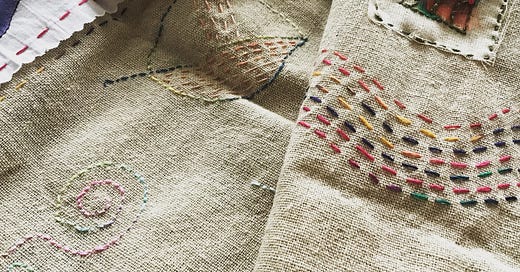




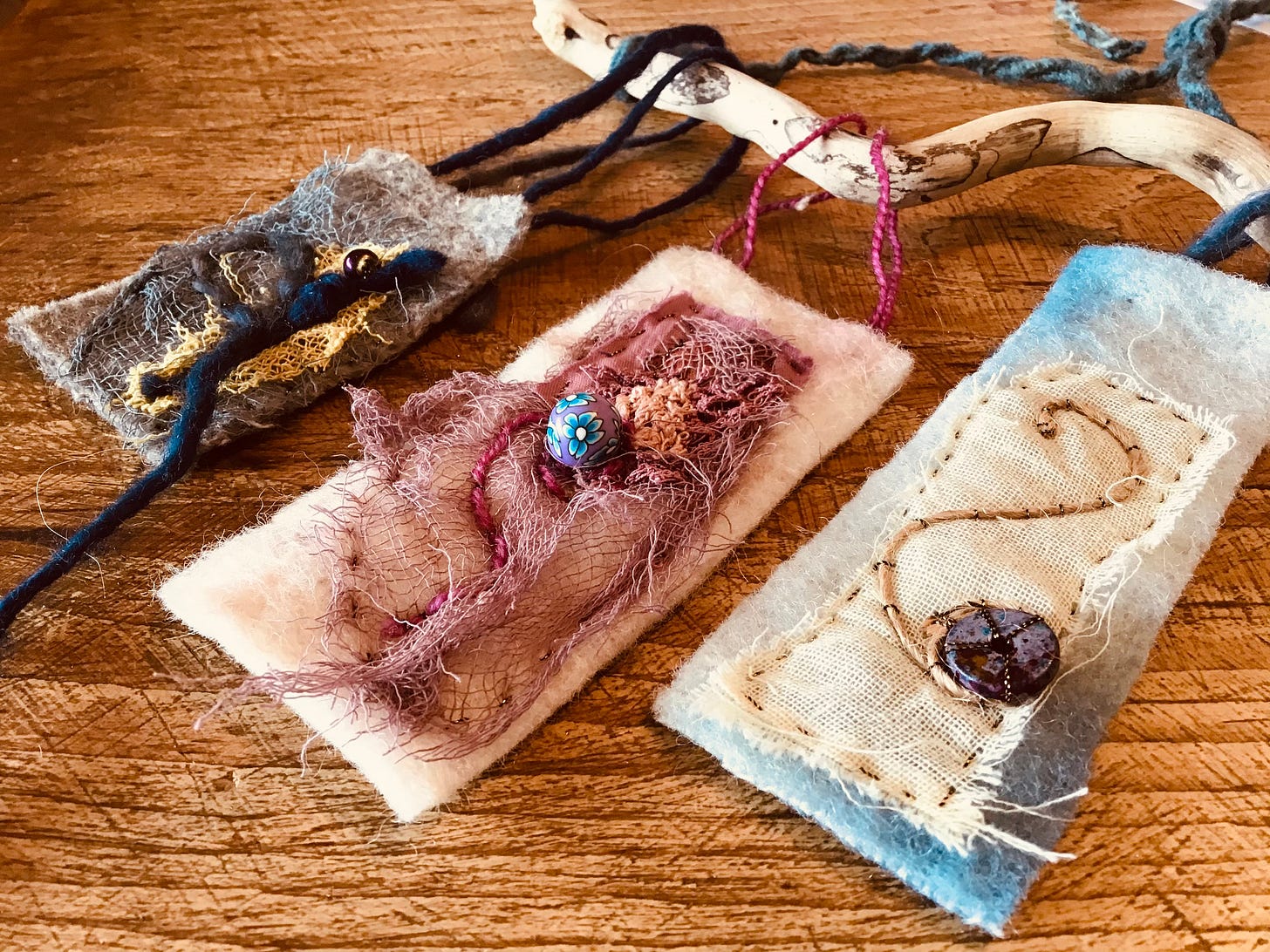

As always a gentle perfectly written piece which resonates with me beautifully. The simplicity of a needle and thread in and out is a meditative state and frees the mind. I’ve had a love of a basket since childhood one for books and one for sewing . I also have many more baskets….
This is absolutely charming and delightful. And synchronistic as well. After finishing a long knitting project, I started working on a little embroidery book I purchased through the Internet. It's travels to get to me is a saga of its own, but it has fueled an urge to add embroidery to my activities. Your photos, though, especially the Kantha stitchwork, inspires a simpler way of decorating AND meditating. There's a reason why women of old spent their evenings stitching and knitting. It went beyond utilitarian necessity. It was also their way of calming down after a hard day of housework, tending to the kitchen garden, and dealing with cantankerous family members. Bravo for reminding us of this drug-free way of enjoying quiet time and recalibration of our nervous systems.